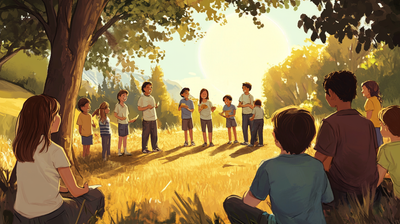Had this lesson last month I thought was gonna be amazing. Spent forever planning it. Good story clear points everything organized perfect.
Kids just sat there staring at me like I was speaking gibberish. Couple started picking at their shoes. One kid straight up asked if we were done yet. We'd been going maybe three minutes.
That's when it hit me. I was doing all the talking and they were doing all the sitting. Which is basically torture for kids who've been stuck in classrooms all week and really just want to move around and actually do something with their bodies.
So I started trying different stuff. Ways to get them actually involved instead of just being my captive audience. Some ideas worked incredible. Others were complete disasters that made me want to hide under a rock.
But I learned what actually gets kids engaged versus what makes them count ceiling tiles and pray for the end.
Just Let Them Move Already
Kids need to move their bodies. Period. Fighting this is like trying to stop rain by yelling at clouds.
Now I build movement into absolutely everything. Acting out Bible stories. Walking around the room while we're discussing stuff. Hand motions for songs. Even just standing up and sitting down at different parts of the lesson.
Last week we did David and Goliath and I had all the kids be the Israelite army. They marched in place when I talked about the soldiers. Looked terrified when I described how huge Goliath was. Jumped up and cheered when David knocked him down.
Way better than just telling them about some battle that happened forever ago.
Sarah's daughter Emma has always been one of those wiggly kids. Used to drive me absolutely nuts trying to get her to sit still and pay attention. Now I have her help me demonstrate stuff for the other kids. Turns her natural energy into a teaching tool instead of a problem I need to solve.
Turns out movement isn't a distraction from learning. It actually helps learning happen way better.
Ask Questions Instead of Lecturing
I used to do basically all the talking. Tell kids exactly what they should know and what they should think and how they should feel about everything.
Now I ask tons more questions instead. "What do you think David was feeling when he saw that giant?" "Why did God pick this little shepherd boy?" "What would you have done in that situation?"
It's amazing what kids come up with when you actually ask them stuff. They notice details I completely miss. Make connections I never would have thought of. Ask questions that are way more interesting than my prepared talking points.
Tommy asked why David didn't just run away and hide when he saw Goliath. That led to this whole discussion about courage and trusting God that was way more meaningful than my planned lecture about being brave.
Questions make kids actually think instead of just trying to absorb whatever I'm dumping on them.
Let Them Be the Storytellers
Instead of me always being the one telling stories I started letting kids take turns. They absolutely love being the center of attention and they remember stuff way better when they're the ones doing the telling.
I give them simple props or let them draw pictures while they're talking. Sometimes I have them work in little groups where each person tells a different part of the story.
Mark's son Jake used to completely zone out during story time. Now he volunteers to tell stories all the time because he gets to be dramatic and funny and make voices. The other kids actually pay way more attention when he's telling the story than when I am.
Turns out kids understand other kids better than they understand adults sometimes. Who knew?
Give Them Stuff to Touch
Everything doesn't have to be just looking and listening. Kids learn through their hands too.
Now I try to bring actual objects whenever I can. Real rocks for David and Goliath. Coins for the parables about money. Sand for all the desert stories. Actual bread when we're talking about Jesus feeding 5000 people.
Last month when I was teaching about mustard seeds I brought real mustard seeds from the grocery store. Kids passed them around and felt how incredibly tiny they were. Made the whole parable make way more sense than just me describing how small the seeds were.
Lisa brought actual sheep wool when we did the shepherd stories. Kids could not get over how soft and fluffy it was. They kept talking about it for weeks afterward.
When kids can actually touch something related to the lesson it sticks in their brains so much better.
Connect It to Their Actual Lives
Bible stories happened a really long time ago in places that are really far away. You gotta help kids see how those ancient stories connect to their real lives right now today.
Instead of just telling the story of the Good Samaritan I ask stuff like "When have you helped someone who really needed it?" "Who helps you when you're hurt or scared?"
When we did the feeding of 5000 we talked about times they've shared their food with friends. Times their families have helped out when someone didn't have enough of something they needed.
Emma mentioned how her family brought dinner to their neighbors when the mom was in the hospital. Perfect example of exactly what Jesus was teaching about taking care of each other.
When kids realize that Bible stories aren't just ancient history but are actually about how we're supposed to live our lives today they care way more about paying attention.
What Absolutely Doesn't Work
Trying to make kids sit perfectly still and quiet the entire time. Making everything into a lecture where you talk and they're supposed to just listen and absorb. Using big complicated words they don't understand. Going way too long without giving them chances to actually participate.
Being completely unprepared and thinking you can just wing it and everything will work out fine. Not having any kind of backup plan for when your brilliant idea crashes and burns. Expecting every single kid to learn the exact same way at the exact same speed.
Getting visibly frustrated when kids are naturally wiggly or talkative instead of working with their energy and using it.
What Actually Works Really Well
Planning specific activities that directly connect to what you're trying to teach. Asking questions that make them actually think about stuff. Giving them regular chances to move and talk and do things with their hands.
Using props and real objects they can touch and examine. Connecting ancient Bible stories to things they experience in their real lives. Letting them help teach each other instead of just being a passive audience.
Being flexible and willing to change course when something clearly isn't working instead of stubbornly pushing through with your original plan.
What I'm Seeing Happen Now
Kids are way more engaged when they're actually part of the lesson instead of just sitting there listening to me talk. They ask way better questions. Remember more of what we covered. Actually talk about it with their parents during the week.
Parents have mentioned that their kids come home and tell them about what we learned because they were involved and excited about it instead of just sitting there being bored.
Kids who used to be disruptive and cause problems now actually help me lead stuff because they have real jobs to do instead of just trying to sit still and be quiet.
Even the really quiet shy kids participate more when there are lots of different ways to be involved that don't require being loud or outgoing.
Still Figuring This Out
Every group of kids is totally different. What works absolutely amazing with one group might completely bomb with a different group. You have to pay attention to your specific kids and adjust accordingly.
Some activities I thought would be incredible turned out to be way too complicated or chaotic for the kids to handle. Others that I was worried about worked out perfectly.
But I've definitely learned that kids learn way better when they're actively doing something instead of just hearing about something.
Interactive teaching takes way more planning and energy upfront but the results are so much better. Kids are actually engaged and excited instead of just trying to endure until it's over.
And honestly that's what we're really going for here.








